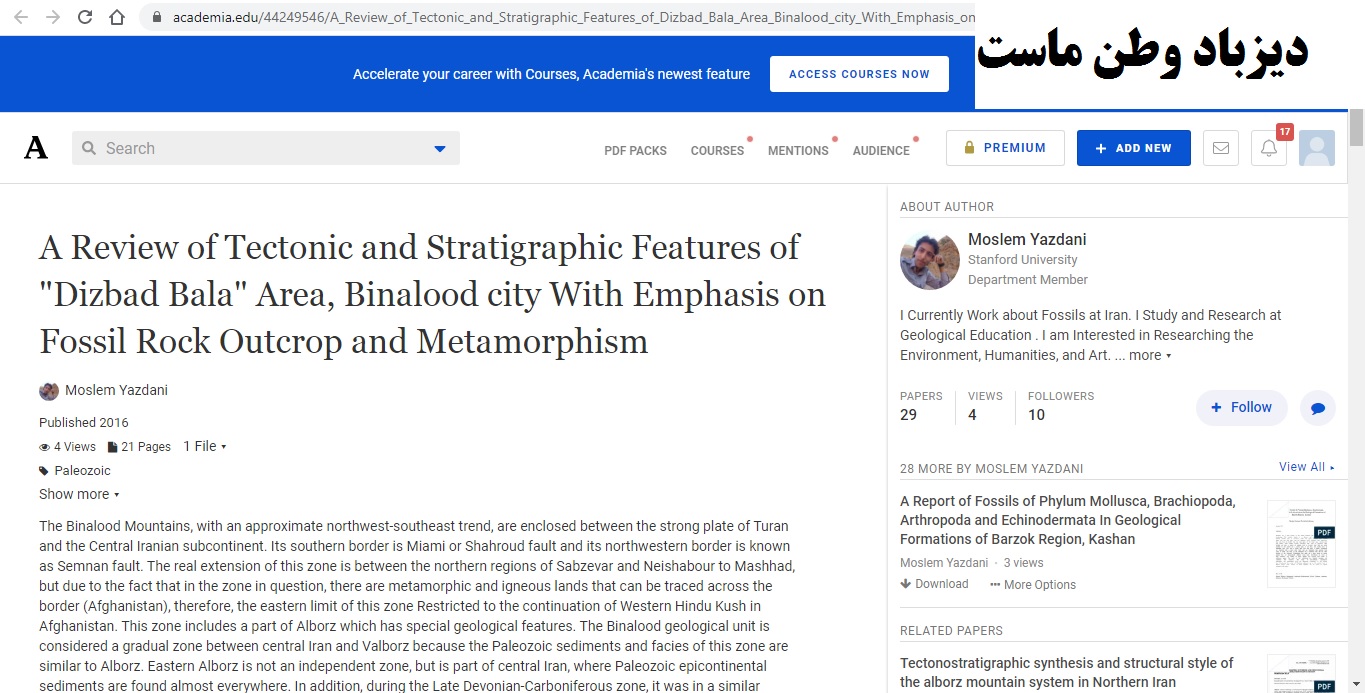
دیزباد وطن ماست
سایت رسمی روستای دیزباد علیا (بالا) از توابع شهرستان نیشابور در استان خراسان رضوی ایران.
دیزباد وطن ماست
سایت رسمی روستای دیزباد علیا (بالا) از توابع شهرستان نیشابور در استان خراسان رضوی ایران.Tectonic and Stratigraphic Features of "Dizbad Bala" Area
Dizbad Watane Mast: A Review of Tectonic and Stratigraphic Features of "Dizbad Bala" Area, Binalood city With Emphasis on Fossil Rock Outcrop and Metamorphism has done by Moslem Yazdani and Published in 2016.

you can find the original page with full article in bellow link:
The Binalood Mountains, with an approximate northwest-southeast trend, are enclosed between the strong plate of Turan and the Central Iranian subcontinent. Its southern border is Miami or Shahroud fault and its northwestern border is known as Semnan fault. The real extension of this zone is between the northern regions of Sabzevar and Neishabour to Mashhad, but due to the fact that in the zone in question, there are metamorphic and igneous lands that can be traced across the border (Afghanistan), therefore, the eastern limit of this zone Restricted to the continuation of Western Hindu Kush in Afghanistan. This zone includes a part of Alborz which has special geological features. The Binalood geological unit is considered a gradual zone between central Iran and Valborz because the Paleozoic sediments and facies of this zone are similar to Alborz. Eastern Alborz is not an independent zone, but is part of central Iran, where Paleozoic epicontinental sediments are found almost everywhere. In addition, during the Late Devonian-Carboniferous zone, it was in a similar situation with the western and central Alborz and in the Permian with other parts of Iran in terms of sedimentary basin. The igneous and metamorphic complex of this zone, which is especially protruding in the south and west of Mashhad, includes three phases of regional metamorphism and two stages of granitization, and there are also ultrabasic masses. The metamorphic and granitic phases of Binalood during the Hersinian orogenic period and later in the Middle Triassic have been totally affected by the Early Cimmerian metamorphism. Continuation of part of the Hersinian orogenic function that reaches south of Mashhad from Tiashan-Pamir-Hindu Kush is the subduction type of oceanic crust. There were fossilized Cambrian sediments in this zone and during the Lower Silurian and Lower Devonian, a common sea covered northeastern Iran and central Iran. Because similar sediments have been left during this period in Binalood and Central Iran. This connection to the lower Carboniferous also existed, while in Alborz this connection was completely cut off. This condition is attributed to the Late Devonian terrestrial movements and is attributed to the lower Carboniferous basal conglomerates. Upper Carboniferous sediments in Binalood include a collection of black and shale quartzite sandstones that are somewhat similar to the Sardar Formation (Tabas - Central Iran).


























